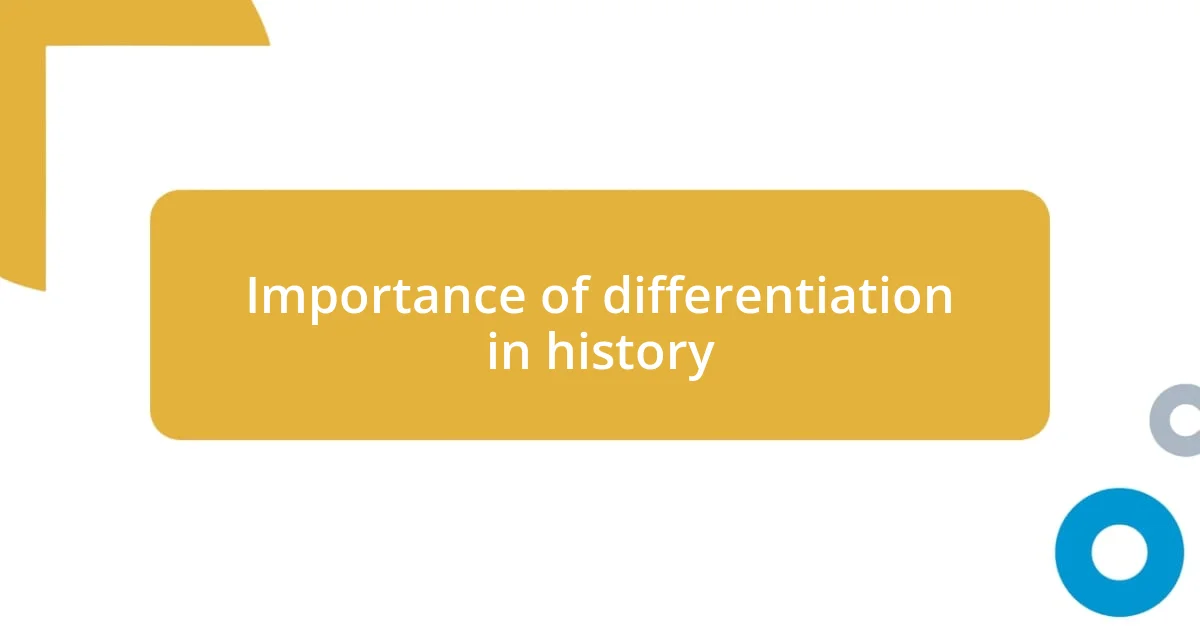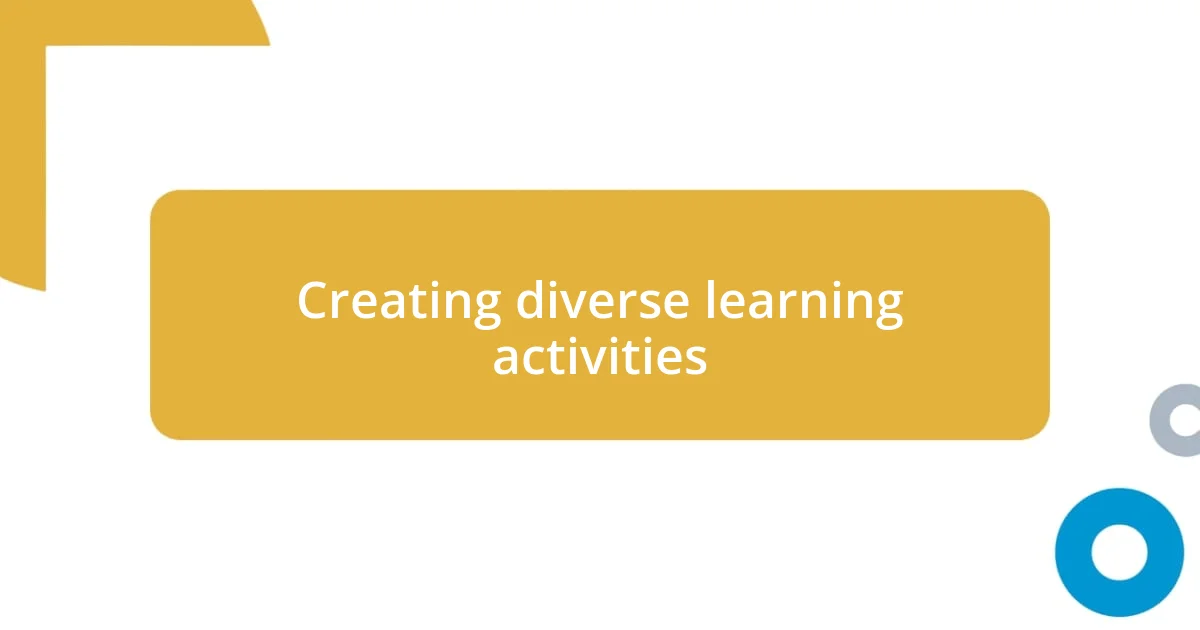Key takeaways:
- Differentiated instruction enhances student engagement by accommodating diverse learning styles, interests, and backgrounds, leading to deeper connections with the material.
- Ongoing assessment and one-on-one interactions are vital for understanding student needs, adjusting teaching strategies, and fostering a culture of ownership in learning.
- Incorporating technology and flexible grouping promotes collaborative learning experiences, allowing students to express their knowledge creatively and dynamically.

Understanding differentiated instruction
Differentiated instruction is all about recognizing the unique strengths and challenges each student brings to the classroom. I remember one year when I had a particularly diverse group of learners. Some thrived on group discussions, while others needed quiet time to process information. This observation played a crucial role in shaping my approach to teaching.
What I love about differentiated instruction is that it encourages creativity in lesson planning. For instance, I once allowed students to choose between a written report, a presentation, or a creative project to demonstrate their understanding of the American Revolution. I could see the pride in their faces as they showcased their unique approaches. Isn’t it amazing how empowering students to express themselves can lead to deeper learning?
At its core, effective differentiation requires ongoing assessment and flexibility. I often ask myself, how can I better support each student’s learning journey? By regularly checking in and adapting my strategies, I foster an environment where every student feels valued and can succeed in their own way. It’s a dynamic process that transforms teaching into a more collaborative and empathetic experience.

Importance of differentiation in history
Differentiation in history is essential because it honors the diverse backgrounds and learning styles of students. I often recall a moment when two students approached me after a lesson on World War II. One was deeply interested in military strategy, while the other was more focused on the social impact of the war. This conversation made me realize that by responding to their individual interests, I could elevate their understanding and connection to the material.
- Fosters Engagement: Students are more invested when the material resonates with them personally.
- Addresses Varied Learning Styles: Incorporating visual, auditory, and kinesthetic methods allows every student to grasp concepts effectively.
- Encourages Critical Thinking: When students engage with content that fits their perspective, they’re more likely to ask meaningful questions and explore deeper connections.
- Promotes Inclusion: Differentiated instruction ensures that all voices are heard, creating a supportive classroom environment.
- Supports Success: Tailoring tasks to suit individual needs can lead to better academic outcomes and increased confidence.
By embracing these elements of differentiation, I’ve watched my students blossom, truly understanding the past and its relevance to their lives. It’s not just about covering content; it’s about building a history that every learner can connect with on some level.

Assessing student learning needs
Understanding the learning needs of my students was always an integral part of my teaching strategy. I remember using informal assessments, such as quick surveys or exit tickets, to gauge students’ comprehension after each lesson. This simple practice illuminated their areas of interest and confusion. For example, during a unit on Ancient Rome, I discovered that many students were excited about Roman architecture but struggled with understanding government structures. Recognizing this allowed me to adjust my lesson plans and provide additional resources where needed.
I’ve found that one-on-one interactions can be incredibly revealing. By taking the time to sit down with students, I learned about their individual learning styles and preferences. I distinctly recall a student named Mia who thrived on visual aids but felt overwhelmed by lengthy texts. After our conversation, I started incorporating more graphic organizers and videos into my teaching. This not only boosted her confidence but also encouraged her classmates to express their own needs, fostering a classroom culture where everyone felt safe to share their struggles and successes.
Ultimately, assessing student learning needs isn’t a one-time event; it’s an ongoing conversation. I often reflect on how assessment shapes not only our teaching methods but the classroom dynamics as well. When students see that they have a say in their education, it encourages a sense of ownership and pride. Wouldn’t you agree that helping students identify their own learning paths fosters a more engaged and motivated classroom environment?
| Assessment Methods | Benefits |
|---|---|
| Informal Assessments | Quick feedback; highlights areas of interest and confusion. |
| One-on-One Interactions | Allows for tailored support based on individual learning styles. |
| Ongoing Conversations | Encourages student ownership and engagement in their learning journey. |

Creating diverse learning activities
Creating diverse learning activities in my history class has been a game changer. I often integrate project-based learning, where students can dive into topics that pique their interest. For instance, during a unit on the Civil Rights Movement, I encouraged students to create presentations, artwork, or even skits that focused on different figures and events. The result? A classroom buzzing with excitement and creativity, as each student found a way to express their thoughts in a manner that felt authentic to them.
Additionally, I’ve found that using technology can significantly enhance learning diversity. In one memorable lesson on the Industrial Revolution, I had students explore interactive timelines and digital simulations. Watching them navigate through historical events, while sitting side by side, was fascinating. It felt like they were travel agents planning a historical journey, each choosing their own locations and experiences. Who wouldn’t be inspired to learn when they have the tools to explore in ways that resonate with them?
I also believe in the power of choice boards—these allow students to select from a variety of tasks that showcase their understanding. During a lesson on the American Revolution, I laid out choices ranging from creating a comic strip to writing a letter from the perspective of a founding father. It was heartwarming to see one shy student shine while crafting a detailed comic, which opened up conversations about her thoughts and insights. Isn’t it rewarding when students can choose their path and express themselves freely? That’s where true learning happens.

Incorporating technology in instruction
Incorporating technology into my history instruction has truly transformed the learning experience for my students. I vividly remember the excitement during a virtual tour of ancient civilizations. As my students donned their headphones and embarked on a digital journey through the pyramids of Egypt, I watched their eyes widen in amazement. It was as if they were stepping into history themselves, and their questions flowed effortlessly. Can you imagine the connections they made as they explored landmarks that once felt distant and abstract?
Another way I’ve leveraged technology is through collaborative platforms, such as Google Classroom, which fosters teamwork among my students. During a recent project on World War II, students worked together online, sharing research and ideas in real-time. I still recall the energy in the virtual discussions; ideas were bouncing back and forth, and their enthusiasm was contagious. How rewarding it is to see students become co-creators of knowledge rather than just passive recipients!
Lastly, I’ve integrated multimedia presentations into my assessments. Instead of a traditional essay, I encouraged students to create interactive presentations using tools like Prezi or Canva. When one of my students, Liam, decided to present his findings on the Vietnam War through a short documentary, I was astounded by his creativity and insight. Watching his peers engage with his work left me pondering: isn’t it incredible how technology can bridge gaps and allow students to communicate their understanding in dynamic ways?

Using flexible grouping strategies
Using flexible grouping strategies in my history class has opened up a world of collaborative learning experiences. I often group students by interests or strengths, allowing them to work together on projects that resonate with them. One unforgettable instance involved a talented group of artists and storytellers collaborating on a mural that depicted significant events of the Civil War. Watching their different skills come together was like witnessing history come alive right before my eyes.
Moreover, I find that mixing up the group compositions regularly keeps the energy vibrant. In one lesson, I intentionally grouped students with varying abilities and backgrounds to discuss World War I. This not only encouraged peer teaching but also led to diverse perspectives emerging during discussions. It struck me how a quiet student shared an insightful connection between the war and a historical event from her culture, prompting others to reflect on their own backgrounds. Isn’t it fascinating how group dynamics can unveil hidden insights?
Furthermore, incorporating choice in grouping strategies helps students feel valued and engaged in their learning. For a unit on the Cold War, I let them choose their working partners based on their interests—whether it was researching espionage or exploring propaganda. One student, usually hesitant to participate, thrived when paired with a friend who was equally passionate about the topic. Seeing them collaborate and bounce ideas off each other was profoundly gratifying. It reminds me that sometimes the best learning happens in the company of peers who share your curiosity and enthusiasm.

Evaluating the effectiveness of differentiation
Evaluating the effectiveness of differentiation can sometimes feel like a moving target, but I’ve learned to look closely at student engagement and understanding. For instance, after implementing personalized learning paths in my history curriculum, I observed a marked increase in participation during discussions. Students who had previously been reticent began to share their thoughts, which made me wonder: how much more can they achieve when they feel empowered to express their unique perspectives?
Feedback is another crucial component in this evaluation process. I routinely ask my students for their thoughts on the differentiated activities. One student mentioned that she felt more connected to the material when it was tailored to her interests, and it hit me how vital it is to listen to their voices. Isn’t it powerful when learners feel their stories matter within the classroom narrative? This connection not only deepened their understanding but also fostered a safe space for exploration.
I also keep an eye on assessments to gauge effectiveness. After introducing varied project formats, like multimedia presentations and creative writing assignments, I noticed significant improvements in my students’ critical thinking skills. It’s rewarding to review their work and see evidence of deeper historical thinking. Reflecting on these experiences, I can’t help but ask: isn’t the ultimate goal of education to cultivate not just knowledgeable individuals, but passionate and engaged citizens?














